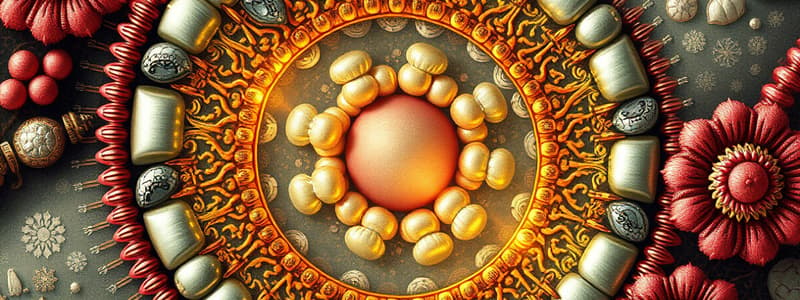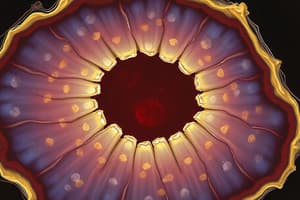Podcast
Questions and Answers
What is the SI unit for measuring temperature?
What is the SI unit for measuring temperature?
- Newton, N
- Fahrenheit, °F
- Celsius, °C
- Kelvin, K (correct)
Which base quantity is measured in kilograms?
Which base quantity is measured in kilograms?
- Electric current
- Time
- Mass (correct)
- Length
How many base quantities are defined in the International System of Units (SI)?
How many base quantities are defined in the International System of Units (SI)?
- Twelve
- Seven (correct)
- Five
- Ten
When reading a metric measurement, how many significant digits will be recorded if the pointer reads 9.0 cm?
When reading a metric measurement, how many significant digits will be recorded if the pointer reads 9.0 cm?
What is the smallest fraction of a centimeter that can be measured with the metric ruler described?
What is the smallest fraction of a centimeter that can be measured with the metric ruler described?
Which unit measures the amount of substance in the SI system?
Which unit measures the amount of substance in the SI system?
What is the building block of proteins?
What is the building block of proteins?
Which type of cell contains a membrane-bound nucleus?
Which type of cell contains a membrane-bound nucleus?
What is the process called when water molecules move across a selectively permeable membrane?
What is the process called when water molecules move across a selectively permeable membrane?
Which cellular division leads to the production of cells with half the ploidy number of the parent cell?
Which cellular division leads to the production of cells with half the ploidy number of the parent cell?
Which type of transport requires the expenditure of energy?
Which type of transport requires the expenditure of energy?
Which of the following elements is not part of nucleic acids?
Which of the following elements is not part of nucleic acids?
Amylase, actin, and myosin are examples of which type of biological molecules?
Amylase, actin, and myosin are examples of which type of biological molecules?
Which of the following statements about prokaryotic cells is true?
Which of the following statements about prokaryotic cells is true?
What is the primary function of the nucleus in a cell?
What is the primary function of the nucleus in a cell?
Which of the following statements is true regarding the cell wall?
Which of the following statements is true regarding the cell wall?
What is the main role of mitochondria in the cell?
What is the main role of mitochondria in the cell?
Which organelle is responsible for protein synthesis?
Which organelle is responsible for protein synthesis?
Which of the following is NOT a function of the Endoplasmic Reticulum?
Which of the following is NOT a function of the Endoplasmic Reticulum?
How does the cell membrane differ from the cell wall?
How does the cell membrane differ from the cell wall?
Which organelle is primarily associated with photosynthesis in plants?
Which organelle is primarily associated with photosynthesis in plants?
What is the function of lysosomes in a cell?
What is the function of lysosomes in a cell?
If a calculation results in the number 2.5689 and it needs to be rounded to three significant figures, what is the correct rounded value?
If a calculation results in the number 2.5689 and it needs to be rounded to three significant figures, what is the correct rounded value?
What does 'accuracy' refer to in the context of measurements?
What does 'accuracy' refer to in the context of measurements?
When rounding the number 4.42 to one significant figure, what is the correct result?
When rounding the number 4.42 to one significant figure, what is the correct result?
If the average value is 10 and the true value is 15, what is the percentage error?
If the average value is 10 and the true value is 15, what is the percentage error?
Which of the following statements about precision is true?
Which of the following statements about precision is true?
When rounding 0.0587 to two significant figures, what is the correct rounded value?
When rounding 0.0587 to two significant figures, what is the correct rounded value?
What distinguishes a chemical change from a physical change?
What distinguishes a chemical change from a physical change?
Which of the following is an example of a phase change?
Which of the following is an example of a phase change?
Which physical property can typically help identify a substance?
Which physical property can typically help identify a substance?
What process describes a solid turning directly into a gas?
What process describes a solid turning directly into a gas?
What is a characteristic of physical properties?
What is a characteristic of physical properties?
What occurs during a chemical change?
What occurs during a chemical change?
What would likely indicate a chemical change has occurred?
What would likely indicate a chemical change has occurred?
Which of the following best describes freezing?
Which of the following best describes freezing?
Flashcards are hidden until you start studying
Study Notes
International System of Units (SI)
- Seven base quantities form the foundation of SI: mass (kilogram, kg), length (meter, m), time (second, s), amount of substance (mole, mol), temperature (kelvin, K), electric current (ampere, A), and luminous intensity (candela, cd).
Reading Metric Measurements
- Significant digits are determined by the number of certain digits plus one uncertain digit, typically a 0 or 5.
- For example, measuring a pencil with a metric ruler may yield a reading of 9.00 cm, including one uncertain digit.
Cell Structure
- Organelles perform specific functions within cells.
- Key organelles:
- Nucleus: Control center coordinating organelle functions.
- Cell Wall/Membrane: Provides rigidity and support (cell wall in plants), selective permeability (cell membrane).
- Mitochondrion: Known as the powerhouse of the cell; site for ATP synthesis.
- Chloroplast: Site of photosynthesis in plants and algae.
- Ribosome: Responsible for protein synthesis.
- Endoplasmic Reticulum: Channels for transporting materials inside the cell.
Cell Types
- Prokaryotic cells: Lack a membrane-bound nucleus; characteristic of bacteria and blue-green algae.
- Eukaryotic cells: Contain membrane-bound nucleus and organelles; typical of protists, fungi, plants, and animals.
Cell Transport Mechanisms
- Passive Transport: No energy required; particles move with the concentration gradient.
- Active Transport: Energy required; particles move against the concentration gradient.
- Diffusion: Movement of solvent molecules from high to low concentration.
- Osmosis: Diffusion of molecules across a selectively permeable membrane.
Cell Reproduction
- Mitosis: Division of somatic cells resulting in daughter cells with equal ploidy.
- Meiosis: Division of germ (sex) cells resulting in daughter cells with half the ploidy of parent cells.
Botany Overview
- Plants are autotrophic and perform photosynthesis.
- Plant cells are eukaryotic.
Rounding Off Numbers
- Rounding rules:
- If the digit removed is less than 5, drop it; e.g., 1.23 to 1.2.
- If the digit is 5 or greater, drop it and increase the preceding digit by one; e.g., 3.46 to 3.5.
Accuracy and Precision
- Accuracy: Closeness of a value to the true value; assessed through percentage error.
- Precision: Agreement among multiple measurements of the same event.
Changes in Matter
- Physical Changes: Alterations in phase or state without changing composition (e.g., melting, freezing, evaporation).
- Chemical Changes: Transformations that convert substances into different substances (e.g., synthesis, decomposition, displacement).
Phase Changes
- Sublimation: Solid to gas.
- Deposition: Gas to solid.
- Melting: Solid to liquid.
- Freezing: Liquid to solid.
- Evaporation: Liquid to gas.
- Condensation: Gas to liquid.
Studying That Suits You
Use AI to generate personalized quizzes and flashcards to suit your learning preferences.




